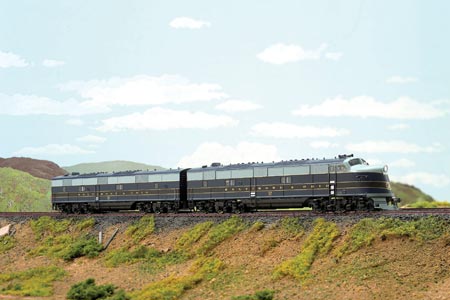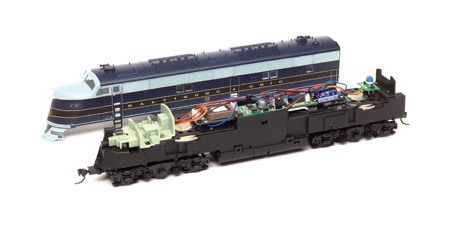The sleek prototypes of these classic models pulled many of the early streamliners, and their success helped Electro-Motive dominate the passenger locomotive market for nearly 25 years.
Background. Electro-Motive’s first E units were 1,800-hp diesel-electric passenger locomotives that were custom-built in 1937 and 1938. The E3s were introduced as 2,000-hp standard production units in 1939, with the E4, E5, and E6 models following by early 1940. The E4s were customized with telescoping nose doors for the Seaboard Air Line, and the E5s had fluted side panels to match the Chicago, Burlington & Quincy’s Zephyrs.
In contrast, the E3 and E6 locomotives shared identical carbodies with long slanted noses, rectangular side windows, and roof-top grills on both sides of the multiple exhaust stacks. These locomotives introduced the basic design that continued long after EMC became the Electro-Motive Division (EMD) of General Motors in January 1941.
Model construction. Our Baltimore & Ohio E6 A-B sample includes a powered A unit and a dummy B unit. However, the A-B-B consists have the A and one B unit powered, and one B unit that isn’t powered.
Interior access is easy if you remove the A unit’s front coupler, gently spread the body sides, and let the chassis slip out.
The carbodies on these models closely match the drawings in the Model Railroader Cyclopedia: Vol. 2, Diesel Locomotives. Each plastic body has sharp detail with neatly applied specific prototype details. The painting and printed lettering is superb, and two different engine numbers are available in all of the paint schemes.
A heavy cast-metal frame gives each 21-ounce power unit plenty of weight for traction. A five-pole can motor and flywheel are mounted above the fuel tank with universals driving all three axles on each truck. This is a minor deviation from the prototype’s A-1-A trucks which had only the end axles powered. These extra powered axles add to the model’s tractive effort without affecting appearance.
Broadway’s EMC passenger trucks have acetal plastic gearboxes that snap together. The wheelsets have nickel-silver wheels mounted on metal stub axles which press into acetal plastic gears. The RP-25 contour wheels and wheelsets match the National Model Railroad Association standards gauge.
A large printed-circuit board on top of the mechanism contains the QSI electronics system and a pair of speakers. It delivers all the features we’ve come to expect from BLI models including automatic DC and DCC operation, and a wide range of programmable sound features.
Our B&O sample set includes an unpowered B unit that’s only four ounces lighter than the A unit. The A unit alone produces sufficient drawbar pull to handle about 26 free-rolling passenger cars on straight and level track.
However, pulling a 16-ounce dummy B unit will reduce the train size by about five cars. Modelers interested in passenger operation will want to remove about 10 ounces of this excess weight to get the B unit closer to the NMRA’s Recommended Practice car weight of 5½-ounces (1 ounce plus ½-ounce per inch of length).
Electronics. The QSI sound system in this locomotive requires a minimum of 4.6 volts DC to operate the idling sounds, so it has a higher starting voltage than unequipped models. Both the starting voltage and top speed are adjustable, but most train operation will take place in the upper half of your throttle’s speed settings if you operate the locomotive on DC.
A 29-page instruction manual explains how to adjust and operate all of these features. For modelers who are new to the programming process, the system is easy to work with and includes a reset function that restores everything to the factory default settings.
I’m especially impressed with the sounds of the horn, EMD diesel engine, and air-actuated bell. The latter even includes the sound of the air-operated clapper an instant ahead of the ringing sound.
Overall, this E6 is an excellent model with a powerful mechanism and great sound. Given the current interest in passenger train modeling, these locomotives will be suitable for any mixed consist of heavyweight and streamline cars into the mid-1960s.
Price: $259.99 each;
A-A sets, $499.99; A-B sets,
$329.99; A-B-B sets,
$549.99; A unit chassis,
$229.99; B unit chassis,
$189.99
Manufacturer
Broadway Limited Imports
P.O. Box 376
Ivy, VA 22945
www.broadway-limited.com
Description
Plastic and metal ready-to-run
passenger diesel locomotive
Road Names
E6 A-B sets (with dummy B):
Atchison, Topeka & Santa
Fe, Atlantic Coast Line,
Baltimore & Ohio, Southern
Ry.
E6 A-A set (both powered):
Chicago, Milwaukee, St. Paul
& Pacific; Illinois Central;
Union Pacific
E6 A: Chicago & North
Western; Chicago, Rock
Island & Pacific; Louisville &
Nashville; Seaboard Air Line
E6 A-B-B set (A and B
powered with dummy B): UP
City of San Francisco, UP
City of Los Angeles
E3: CRI&P (Rock Island),
Kansas City Southern
Features
Die-cast frame
Directional constant lighting
Drawbar pull: 5.6 ounces (26
passenger or 78 freight cars
on straight, level track)
Dual-mode automatic decoder
for use on either DC or Digital
Command Control (DCC)
Dual-mode QSI sound system
Engine weight: 21 ounces
Five-pole motor with flywheel
Kadee magnetic couplers
mounted at the correct height
Lighted number boards
Minimum radius: 18″
Plastic body with cab interior
Properly gauged NMRA RP-25
contour wheelsets
Prototype-specific detailing















